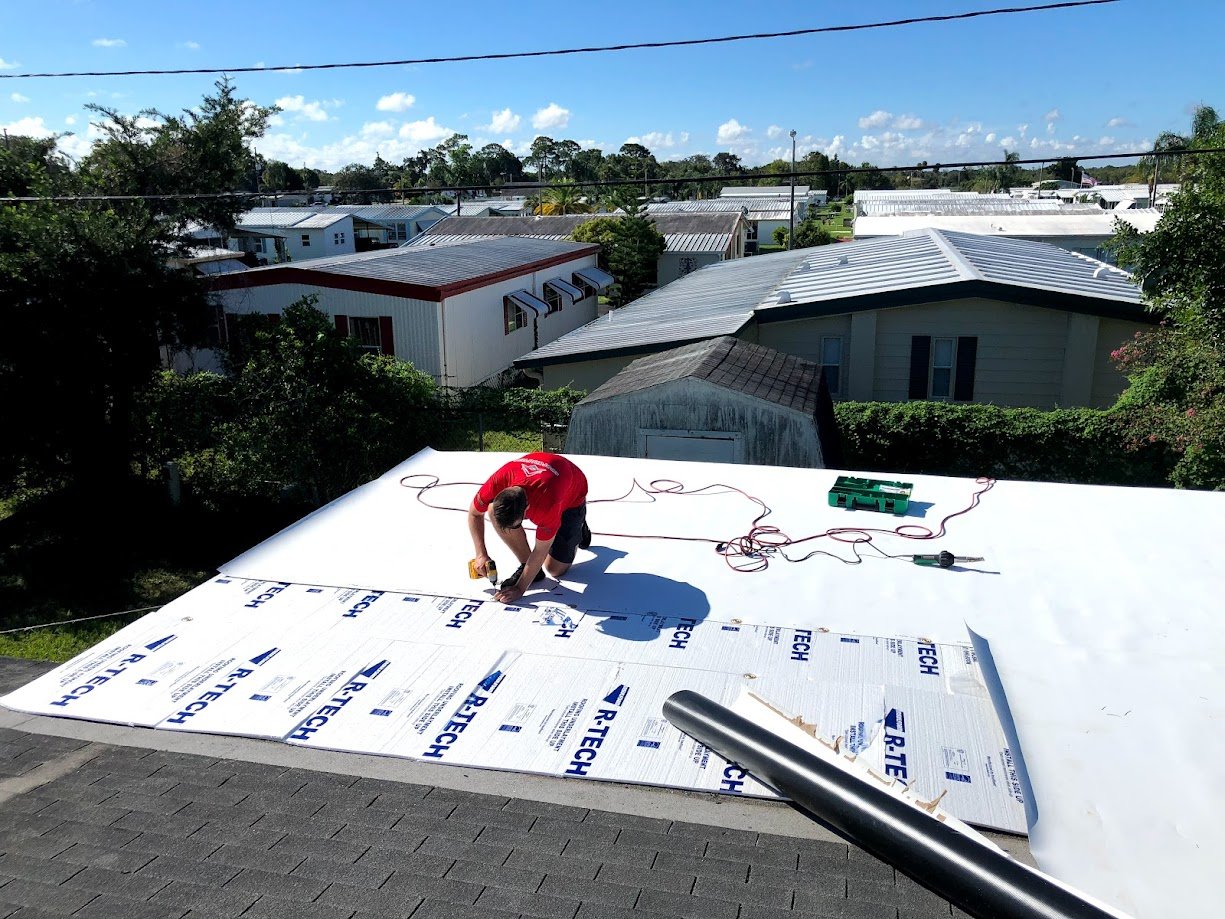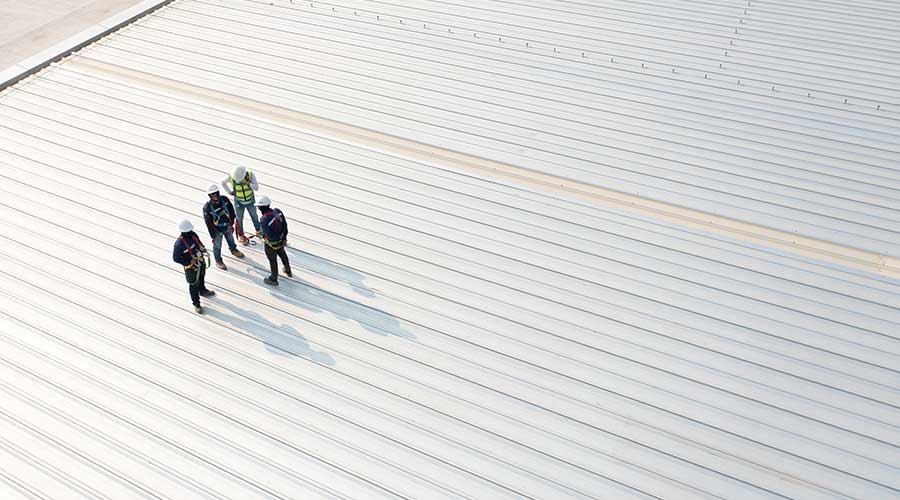Cool Roof Technology enhances building energy efficiency by reflecting more sunlight and absorbing less heat. It significantly lowers cooling costs and indoor temperature.
Cool roof systems are revolutionizing the way we approach energy consumption in buildings. By integrating materials that reflect solar energy and emit absorbed heat, these roofs provide a practical and cost-effective solution to reduce energy use and improve indoor comfort.
With energy savings and sustainability at the forefront of modern design, cool roofs offer an innovative method for homeowners and businesses to lessen their environmental footprint while also achieving financial benefits. This technology not only contributes to the reduction of urban heat islands but also extends the lifespan of roofing materials, making it a smart investment for the eco-conscious. Embracing cool roof technology is a strategic move towards more sustainable living and operational efficiency.
The Concept Of Cool Roofs
When the summer sun blazes down on a building, traditional roofing materials can absorb and retain heat, leading to higher indoor temperatures and increased energy bills. Enter the groundbreaking solution of cool roof technology. This innovative approach transforms roofs from heat sinks to heat deflectors. In the following sections, we’ll dive deeper into what cool roofs are, how they are constructed, and why they stand out against conventional roofing options.
Definition Of Cool Roofs And Their Purpose
Cool roofs are designed to reflect more sunlight and absorb less heat than standard roofs. Constructed from highly reflective materials, these roofs aim to lower roof surface temperatures during peak heat conditions. The ultimate purpose is twofold: enhancing indoor comfort without over-reliance on air-conditioning, and contributing to the reduction of urban heat islands, thereby mitigating the impact on the surrounding environment.
Materials And Surfaces Defining Cool Roofs
- Reflective Paints: A simple yet effective layer that can be applied to existing roofing materials.
- Sheet Covering: A protective, reflective sheeting often installed on commercial buildings.
- Modified Bitumen: Roofing membranes mixed with reflective materials for better heat management.
- Single-Ply Membranes: Prefabricated roofing materials designed to be inherently cool.
- Tile and Metal Roofing: Materials that can be naturally reflective or treated to enhance their cool properties.
Each material offers different benefits, balancing between reflectivity, durability, and cost-effectiveness to suit various climates and building types.
Comparison With Conventional Roofing
| Cool Roofs | Conventional Roofs |
|---|---|
| High solar reflectance | Low solar reflectance |
| Reduced heat absorption | Significant heat absorption |
| Lower energy costs for cooling | Higher energy costs for cooling |
| Enhanced indoor comfort | Potential for overheating indoors |
| Minimization of urban heat islands | Contributes to urban heat islands |
Unlike conventional roofing options, cool roofs stand their ground exceptionally well under the glaring sun, maintaining a cooler temperature both on the outside and within the building. This leads to a cascade of benefits, including a significant reduction in energy usage and a positive environmental impact.
Energy Efficiency Mechanics
The quest for energy-efficient building solutions is bringing new technologies to the forefront, with cool roofs being one of the most effective. The mechanics behind this innovative technology are simple yet profoundly impactful in reducing energy consumption and promoting sustainability. Cool roofs are designed to reflect more sunlight and absorb less heat than a standard roof, leading to a series of benefits that extend beyond mere energy savings. Let’s dive into the specifics of these energy efficiency mechanics.
How Cool Roofs Reflect Sunlight
Traditional roofing materials often absorb a significant amount of the sun’s energy, leading to heat accumulation within a building’s structure. Cool roofs, on the other hand, embrace the science of high solar reflectance. This advanced technology uses reflective paints, a layer of reflective tiles, or shingles to reflect the solar radiation away from the building.
- Reflective Pigments: Pigments specially designed to reflect ultraviolet and infrared rays without absorbing heat.
- Cool Roof Coatings: Protective substances that increase reflectivity and are applied like paint to existing roof surfaces.
- Reflective Roof Materials: Roofing materials inherently designed to have higher albedo — the measure of reflection ability.
Heat Transfer Reduction In Buildings
By minimizing the absorption of heat, cool roofs play a critical role in reducing the heat transfer into buildings. The reduced heat gain results in minimal strain on air conditioning systems, cutting down electricity usage significantly. Insulation combined with cool roof technology ensures an effective barrier against heat transfer.
- Lowered roof surface temperature.
- Decreased thermal gradient between the roof and the interior spaces.
- Reduction in thermal expansion and contraction of roof materials, enhancing durability.
Impact On Indoor Temperature
The interior temperature of a building is inextricably linked to the heat that is transferred through the roofing material. Cool roofs maintain a steadier internal climate by safeguarding the building against extreme temperature fluctuations. This thermal regulation translates to a more comfortable living environment and a significant drop in the need for artificial temperature control systems.
| Conventional Roof | Cool Roof |
|---|---|
| Higher internal temperatures | Stabilized internal temperatures |
| Increased HVAC load | Decreased HVAC load |
| Irregular temperature distribution | Uniform temperature distribution |
Cool Roof Technology Advancements
In the quest for greater energy efficiency, cool roof technology stands out as a game-changer. Through reflective roofing materials and innovative design, cool roofs maintain a lower temperature than traditional roofs under the same conditions. This ‘coolness’ translates into reduced energy bills, enhanced comfort indoors, and a minimized urban heat island effect. Let’s dive into the latest advancements that are shaping the cool roof landscape.
Recent Innovations In Cool Roofing Materials
Industry research and development teams are continually pushing the boundaries to create materials that are not only more effective at reflecting sunlight but also durable and cost-effective. Here’s a glimpse into the latest advancements:
- Photovoltaic Solar Reflective Shingles: Merging solar technology with cool roof principles, these shingles capture solar energy while reflecting a vast majority of sunlight.
- Thermally Broken Roof Panels: These advanced panels reduce heat transfer and offer enhanced insulation.
- Eco-Friendly Coatings: New environmentally friendly coatings not only reflect infrared radiation but are also low in volatile organic compounds (VOCs).
- Phase Change Materials (PCMs): Incorporated into roofing materials, PCMs adjust their state with temperature changes to help regulate roof surface temperatures.
Case Studies On Cool Roof Technology Implementation
A look at real-world implementations of cool roof technology reveals its impact. Consider these notable case studies:
| Project | Location | Results |
|---|---|---|
| Commercial Building Retrofit | Phoenix, AZ | Reduced peak cooling demand by 18% |
| Residential Housing Development | Los Angeles, CA | Lowered indoor temperatures by 2-3°F |
| Industrial Facility Upgrade | Atlanta, GA | Saved 22% in annual air conditioning costs |
Future Trends In Cool Roofing Design
As the benefits of cool roofing become increasingly evident, we anticipate a surge in innovative designs. Some expected trends include:
- Integrated Green Roofs: Combining the thermal regulation of green plants with cool roof technology for multifunctional solutions.
- Responsive Materials: Roofs that adapt to environmental changes in real-time to optimize energy efficiency.
- Building-Integrated Photovoltaic (BIPV): Roofs designed from the outset to serve as both protective shelters and energy generation systems.
These trends underscore a dynamic shift towards smart, cost-effective, and sustainable roofing solutions that promise to redefine our built environment.
Benefits Beyond Energy Savings
While cool roof technology is celebrated for its ability to reduce energy use and lower indoor temperatures, its advantages extend far beyond mere energy savings. From mitigating urban heat islands to improving public health, cool roofs are a smart investment with a breadth of benefits. Let’s delve into some of the additional rewards that accompany the adoption of cool roof systems.
Environmental Implications Of Cool Roofs
Environmental conservation is a critical priority in today’s world, and cool roofs offer significant ecological advantages. Firstly, by reflecting solar energy, these roofs reduce the amount of heat transferred into buildings, which means cooling systems consume less electricity. A lower demand on power plants means less fuel burned and a decrease in greenhouse gas emissions. Cool roofs also lower surrounding air temperatures, lessening the urban heat island effect. This, in turn, can reduce smog formation, which is heightened by higher temperatures. Hence, cool roofs offer a tangible solution to combat urban environmental challenges.
Enhanced Comfort And Health Benefits
One of the most immediate impacts of cool roof technology is felt in the enhanced comfort of building occupants. By maintaining a cooler environment indoors, cool roofs help reduce the risk of heat-related illnesses and stress, promoting a healthier living and working space. Furthermore, with less reliance on air conditioning, there’s a reduction in indoor pollutants and an improvement in air quality. This aspect of cool roof technology plays a crucial role in contributing to overall well-being and productivity.
Financial Incentives And Rebates For Adoption
To encourage the adoption of cool roofs, many government entities and utilities now offer financial incentives and rebates. These can take the form of upfront cost reductions, tax credits, or even performance-based incentives that reward energy conservation. Detailed outlines of these incentives can typically be found through local government websites or energy efficiency programs. As an example:
| Type of Incentive | Description | Potential Benefit |
|---|---|---|
| Tax Credit | A credit which can be applied to income tax | Reduces tax liability for the year of installation |
| Rebate | A refund for part of the purchase price | Immediate cost savings |
These incentives not only lessen the financial burden of cool roof installation but also shorten the payback period for the investment. Builders, homeowners, and business owners alike can benefit from researching available options, potentially turning a long-term energy-saving solution into an attractive short-term investment.
Integrating Cool Roofs In Building Design
The incorporation of cool roof technology is a game-changer in achieving energy efficiency within the built environment. Cool roofs reflect more sunlight and absorb less heat than standard roofs, leading to lower building temperatures and significant energy savings. As architects and engineers seek innovative ways to enhance sustainability, the integration of cool roofs during both the design of new buildings and the retrofitting of existing structures remains a top priority.
Considerations For Retrofitting Existing Roofs
When looking to upgrade an existing roof with cool roof technology, there are several key considerations to ensure the project’s success:
- Determine the current roof condition: Assessing the existing roof for damage or wear is crucial before installation.
- Mitigate thermal expansion: Cool roofs may affect the thermal characteristics of a building. Necessary precautions should be in place.
- Building code compliance: Ensuring the retrofit complies with local building codes is essential for legality and safety purposes.
Best Practices For Integrating Cool Roofs In New Construction
Implementing cool roof technology from the outset of building design is optimal. Here are some best practices to consider:
- Material Selection
- Choose materials with high solar reflectance and thermal emittance values.
- Insulation
- Incorporate proper insulation to complement the cool roof and enhance overall energy efficiency.
- Professional Consultation
- Seek expertise from roofers and architects who understand cool roof implementation in varying climates.
Challenges And Solutions In Cool Roof Maintenance
Though beneficial, cool roofs can present unique maintenance challenges. Solutions to these include:
| Challenge | Solution |
|---|---|
| Accumulated Dirt | Regular cleaning schedules to preserve reflective efficiency. |
| Moisture Issues | Implement vapor barriers and proper drainage to prevent water damage. |
| Biological Growth | Use anti-algae and anti-fungal treatments, especially in humid climates. |

Credit: www.roof-crafters.com
Frequently Asked Questions Of Exploring Cool Roof Technology For Energy Efficiency
What Is Cool Roof Technology?
Cool roof technology involves roofing materials that reflect more sunlight and absorb less heat. This results in a cooler building, reducing air conditioning needs and energy costs.
How Do Cool Roofs Improve Energy Efficiency?
Cool roofs improve energy efficiency by reflecting solar energy. This decreases the heat absorbed, lowering the need for air conditioning and hence, reduces energy consumption.
Can Cool Roofs Reduce Urban Heat Islands?
Yes, cool roofs can mitigate urban heat islands. They reflect sunlight away from buildings and streets, which helps lower ambient temperatures in densely populated areas.
What Materials Are Used For Cool Roofs?
Cool roofs are made using reflective shingles, tiles, or a protective coating. Materials differ by climate but generally include solar-reflective paint, sheet coverings, or reflective tiles or shingles.
Conclusion
Embracing cool roof technology marks a smart step towards sustainable living. With its capacity to reflect sunlight and reduce heat absorption, it slashes energy costs effectively. This innovative approach not only cools our homes, but also our planet, battling the urban heat island effect.
Let’s prioritize eco-friendly choices and invest in cool roofing for a greener future.

